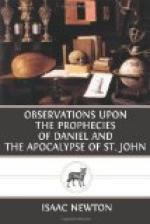The second and third Empires, represented by the Bear and Leopard, are again represented by the Ram and He-Goat; but with this difference, that the Ram represents the kingdoms of the Medes and Persians from the beginning of the four Empires, and the Goat represents the kingdom of the Greeks to the end of them. By this means, under the type of the Ram and He-Goat, the times of all the four Empires are again described: I lifted up mine eyes, saith [1] Daniel, and saw, and behold there stood before the river [Ulai] a Ram which had two horns, and the two horns were high, but one was higher than the other, and the higher came up last.—And the Ram having two horns, are the kings of Media_ and Persia_: not two persons but two kingdoms, the kingdoms of Media and Persia; and the kingdom of Persia was the higher horn and came up last. The kingdom of Persia rose up, when Cyrus having newly conquered Babylon, revolted from Darius King of the Medes, and beat him at Pasargadae, and set up the Persians above the Medes. This was the horn which came up last. And the horn which came up first was the kingdom of the Medes, from the time that Cyaxares and Nebuchadnezzar overthrew Nineveh, and shared the Empire of the Assyrians between them. The Empires of Media and Babylon were contemporary, and rose up together by the fall of the Assyrian Empire; and the Prophecy of the four Beasts begins with one of them, and that of the Ram and He-Goat with the other. As the Ram represents the kingdom of Media and Persia from the beginning of the four Empires; so the He-Goat represents the Empire of the Greeks to the end of those Monarchies. In the reign of his great horn, and of the four horns which succeeded it, he represents this Empire during the reign of the Leopard: and in the reign of his little horn, which stood up in the latter time of the kingdom of the four, and after their fall became mighty but not by his own power, he represents it during the reign of the fourth Beast.
The rough Goat, saith Daniel, is the King of Grecia, that is, the kingdom; and the great horn between his eyes is the first King: not the first Monarch, but the first kingdom, that which lasted during the reign of Alexander the great, and his brother Aridaeus and two young sons, Alexander and Hercules. [2] Now that [horn] being broken off, whereas four [horns] stood up for it, four kingdoms shall stand up out of the nation [of the Greeks], but not in his [the first horn’s] power. The four horns are therefore four kingdoms; and by consequence, the first great horn which they succeeded is the first great kingdom of the Greeks, that which was founded by Alexander the great, An. Nabonass. 414, and lasted till the death of his son Hercules, An. Nabonass. 441. And the four are those of Cassander, Lysimachus, Antigonus, and Ptolemy, as above.




